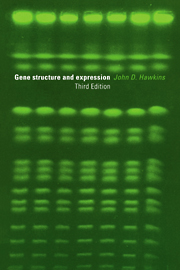Book contents
- Frontmatter
- Contents
- Introduction to the third edition
- Introduction to the second edition
- Introduction to the first edition
- List of abbreviations
- 1 Deoxyribonucleic acid (DNA)
- 2 Ribonucleic acid (RNA)
- 3 Methodology
- 4 Prokaryotic DNA replication and gene expression
- 5 The operon concept
- 6 Eukaryotic gene organisation and replication
- 7 Eukaryotic transcription
- 8 Post-transcriptional processing of RNA
- 9 Oncogenes
- 10 Haemoglobin
- 11 Proteins of the immune system
- 12 Some gene families
- 13 Mitochondrial and chloroplast genomes
- 14 Different and evolving genomes
- Glossary
- Reading lists
- Index
7 - Eukaryotic transcription
Published online by Cambridge University Press: 05 June 2012
- Frontmatter
- Contents
- Introduction to the third edition
- Introduction to the second edition
- Introduction to the first edition
- List of abbreviations
- 1 Deoxyribonucleic acid (DNA)
- 2 Ribonucleic acid (RNA)
- 3 Methodology
- 4 Prokaryotic DNA replication and gene expression
- 5 The operon concept
- 6 Eukaryotic gene organisation and replication
- 7 Eukaryotic transcription
- 8 Post-transcriptional processing of RNA
- 9 Oncogenes
- 10 Haemoglobin
- 11 Proteins of the immune system
- 12 Some gene families
- 13 Mitochondrial and chloroplast genomes
- 14 Different and evolving genomes
- Glossary
- Reading lists
- Index
Summary
Eukaryotes produce three different RNA polymerases for transcribing nuclear genes. These are all very large proteins with multiple subunits and molecular masses in the range of 500,000 to 700,000 daltons (Da). Their catalytic subunits with molecular masses of around 200,000 Da are among the largest known single polypeptide chains. Some of the subunits are common to two or even all three of the enzymes. Each of them transcribes a particular set of nuclear genes. Polymerase I (pol I or pol A), with 13 subunits, transcribes the genes for precursors to rRNAs; polymerase II (pol II or pol B) (12 subunits) transcribes genes into mRNAs encoding proteins; polymerase III (pol III or pol C) (15 subunits) transcribes genes for tRNAs and some other small RNAs. An RNA polymerase with a simpler structure that transcribes mitochondrial genes is encoded by a nuclear gene.
Each polymerase requires a number of transcription factors (TFs) in order to bind to the DNA template and initiate and maintain transcription. A protein called TATA binding protein (TBP) binds to the sequence known as the Goldberg–Hogness or TATA box (consensus sequence TATAAA – Table 7.1), usually situated about 30 bp 5′- to the major site of initiation of transcription of mRNAs by pol II. TBP is also a TF for genes transcribed by pol I and pol III even though they rarely contain a TATA box.
- Type
- Chapter
- Information
- Gene Structure and Expression , pp. 95 - 109Publisher: Cambridge University PressPrint publication year: 1996



